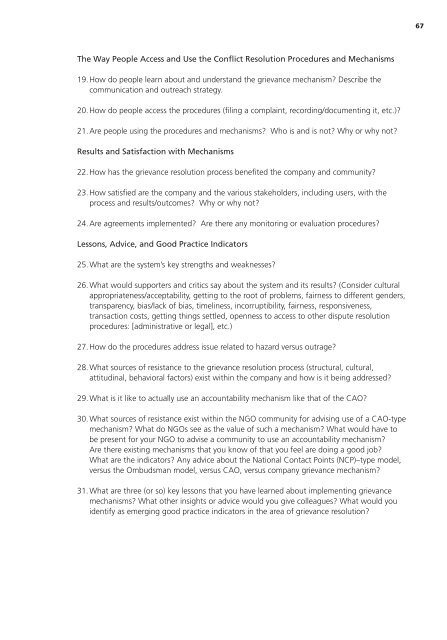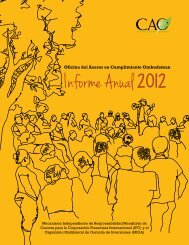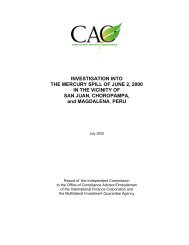A Guide to Designing and Implementing Grievance Mechanisms for ...
A Guide to Designing and Implementing Grievance Mechanisms for ...
A Guide to Designing and Implementing Grievance Mechanisms for ...
Create successful ePaper yourself
Turn your PDF publications into a flip-book with our unique Google optimized e-Paper software.
The Way People Access <strong>and</strong> Use the Conflict Resolution Procedures <strong>and</strong> <strong>Mechanisms</strong><br />
19. How do people learn about <strong>and</strong> underst<strong>and</strong> the grievance mechanism? Describe the<br />
communication <strong>and</strong> outreach strategy.<br />
20. How do people access the procedures (filing a complaint, recording/documenting it, etc.)?<br />
21. Are people using the procedures <strong>and</strong> mechanisms? Who is <strong>and</strong> is not? Why or why not?<br />
Results <strong>and</strong> Satisfaction with <strong>Mechanisms</strong><br />
22. How has the grievance resolution process benefited the company <strong>and</strong> community?<br />
23. How satisfied are the company <strong>and</strong> the various stakeholders, including users, with the<br />
process <strong>and</strong> results/outcomes? Why or why not?<br />
24. Are agreements implemented? Are there any moni<strong>to</strong>ring or evaluation procedures?<br />
Lessons, Advice, <strong>and</strong> Good Practice Indica<strong>to</strong>rs<br />
25. What are the system’s key strengths <strong>and</strong> weaknesses?<br />
26. What would supporters <strong>and</strong> critics say about the system <strong>and</strong> its results? (Consider cultural<br />
appropriateness/acceptability, getting <strong>to</strong> the root of problems, fairness <strong>to</strong> different genders,<br />
transparency, bias/lack of bias, timeliness, incorruptibility, fairness, responsiveness,<br />
transaction costs, getting things settled, openness <strong>to</strong> access <strong>to</strong> other dispute resolution<br />
procedures: [administrative or legal], etc.)<br />
27. How do the procedures address issue related <strong>to</strong> hazard versus outrage?<br />
28. What sources of resistance <strong>to</strong> the grievance resolution process (structural, cultural,<br />
attitudinal, behavioral fac<strong>to</strong>rs) exist within the company <strong>and</strong> how is it being addressed?<br />
29. What is it like <strong>to</strong> actually use an accountability mechanism like that of the CAO?<br />
30. What sources of resistance exist within the NGO community <strong>for</strong> advising use of a CAO-type<br />
mechanism? What do NGOs see as the value of such a mechanism? What would have <strong>to</strong><br />
be present <strong>for</strong> your NGO <strong>to</strong> advise a community <strong>to</strong> use an accountability mechanism?<br />
Are there existing mechanisms that you know of that you feel are doing a good job?<br />
What are the indica<strong>to</strong>rs? Any advice about the National Contact Points (NCP)–type model,<br />
versus the Ombudsman model, versus CAO, versus company grievance mechanism?<br />
31. What are three (or so) key lessons that you have learned about implementing grievance<br />
mechanisms? What other insights or advice would you give colleagues? What would you<br />
identify as emerging good practice indica<strong>to</strong>rs in the area of grievance resolution?<br />
67





